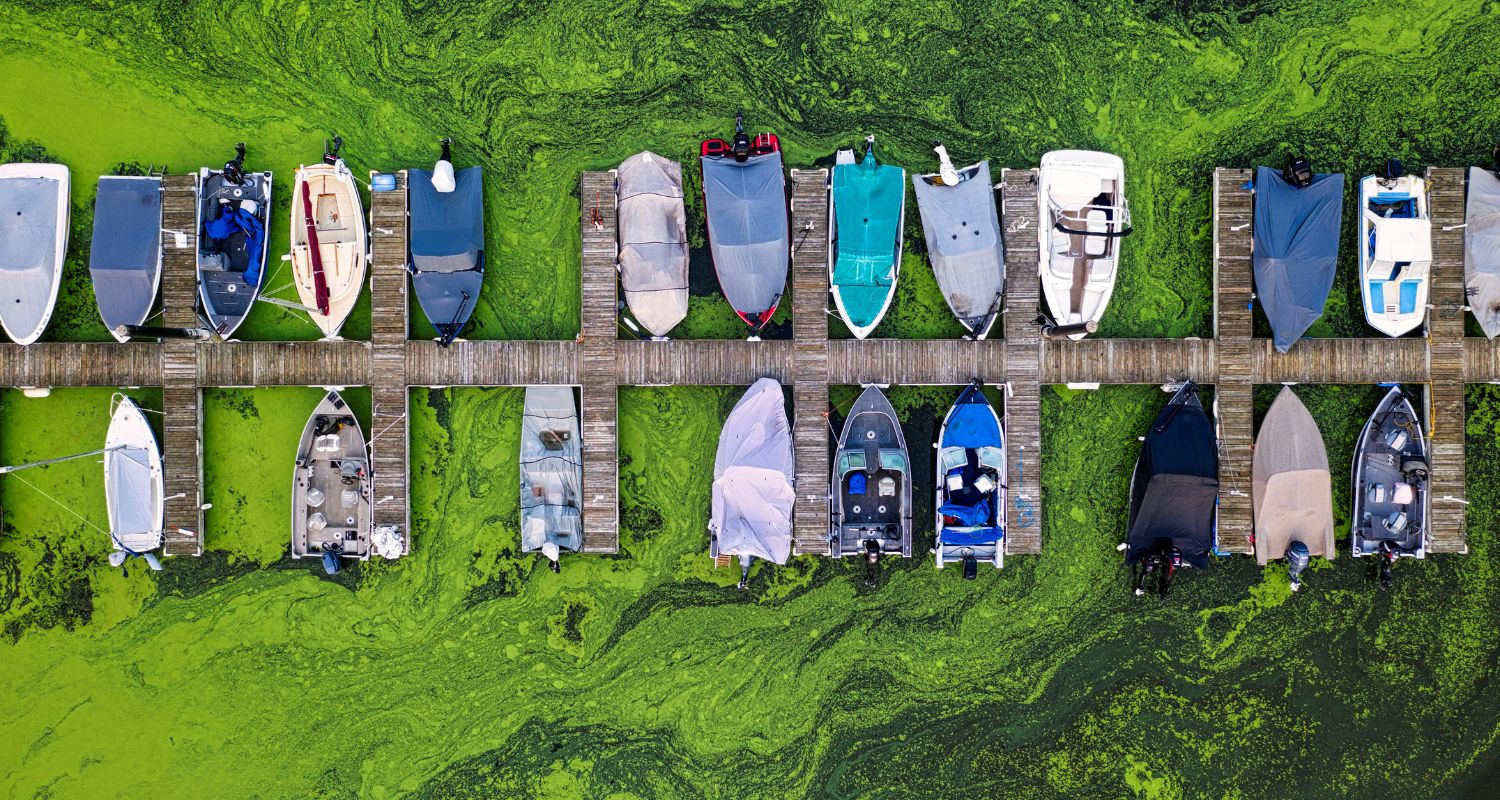
Do Pond Fountains Help With Algae?
If your pond turns green every summer or you’re fighting off stringy mats near your dock, it’s fair to wonder: do pond fountains help with algae? The answer is yes — but only if you know what kind of fountain you have and what’s really causing the algae in the first place.
Most people buy a fountain expecting it to be the fix. But as Holly, our founder, likes to say: “The biggest mistake people make is using a fountain to control algae.”

Let’s break down what fountains actually do, what they don’t, and how to stop algae from coming back year after year.
💦 How Fountains Help with Algae
Algae thrives in warm, still, nutrient-rich water. Fountains work against that by:
- 🌀 Circulating surface water to prevent stagnation
- 🌬️ Adding oxygen to the upper layer, supporting good bacteria
- ☀️ Disrupting surface tension so sunlight can’t supercharge algae growth
But here’s the key: not all fountains aerate. Many decorative fountains look dramatic but barely move enough water to change your pond’s oxygen levels.
If you're serious about water quality, you’ll want a true aerating fountain — one that uses a propeller, not an impeller. These are more durable around algae, better at oxygen transfer, and often have that classic “V” or umbrella-shaped spray pattern.
"Most customers don’t even know what kind of fountain they have. They call decorative fountains 'aerators' without realizing they’re not really helping the water quality much."
– Holly, Founder of EverBlue Pond
If you’re unsure about the difference, our guide on pond fountains vs aerators breaks it all down clearly.
🌴 Do Pond Fountains Help with Algae in Florida?
Algae is especially aggressive in Florida and other warm climates. Long sunny days + warm water + fertilizer runoff = a perfect algae storm.
Yes, fountains help slow algae growth in Florida, but only if:
- You size the fountain correctly
- You run it long enough (see below)
- You’ve already removed existing algae
Still have buildup along your shoreline? You might consider a directional water mover like the Scott Aerator Aquasweep instead.

⚠️ What Fountains Can’t Do (Alone)
This is where expectations matter. Fountains help prevent algae, but they rarely eliminate it by themselves. If your pond is already covered, here’s what to do:
- Remove the algae first – Rake it out or treat with a safe algaecide
- Break the nutrient cycle – This is the root cause. If you don’t remove the nutrients fueling algae, it’ll just come back
- Add movement + oxygen – That’s where your aerating fountain steps in
Also, most fountains only reach the top 4–6 feet of the water column. If your pond is deeper than that, pair your fountain with a diffused aeration system to tackle stratification and muck at the base.
🔁 How Long Should You Run Your Fountain?
If your goal is algae prevention: 8–12 hours a day on a timer is usually fine (and easier on your fountain).

If your goal is algae elimination: run it 24/7. Especially in warm months when blooms are most likely.
"If your pond is already green, you have to go all in — remove the algae, add beneficial bacteria, and keep the fountain running around the clock."
– Holly
📏 Proper Sizing: The Silent Dealbreaker
A too-small fountain won’t move enough water to make a difference. As a general rule:
- Use 1.5 HP for every 1 surface acre
- If your pond is larger than 2 acres, spread the horsepower across multiple fountains
For example, if you have a 3-acre pond, two 1.5 HP fountains are better than one large unit stuck in the middle.
🧪 Should You Add Bacteria?
Yes. Every time. We strongly recommend pairing your fountain with a natural bacteria treatment like Kasco Pond Probiotics. It’s safe, non-chemical, and doesn’t require permits. It:
- 🌿 Reduces muck and sludge
- 💨 Neutralizes odors
- 💧 Helps clear water by reducing excess nutrients
Apply it spring through fall — any time water temps are above 55°F. It’s a game-changer when used alongside an aerating fountain.

👀 Signs It’s Working
Within a few weeks of running your properly sized fountain (and using bacteria), you should notice:
- Clearer water
- Less surface algae
- Fewer odors
- More visible fish activity
If things aren’t improving after a few weeks, contact us. We’ll walk through your setup and figure out what’s missing.
💡 Choosing the Right Fountain
The type of fountain you choose makes a huge difference. Here’s how to pick one that actually helps:
- Aerating Fountains – Best for algae control, oxygen transfer, and movement
Want looks AND algae control?
Pair the following fountains with a diffused aeration system
- Decorative Fountains – Great if you want a beautiful spray and light surface movement
- Fountains with Lights – All the visual benefits of a decorative fountain, plus a dramatic nighttime display
- Commercial Fountains – Big, bold displays made for HOAs, golf courses, and high-visibility properties
Start with our full pond fountain collection or reach out with your pond size — we’ll help you dial it in.

✅ Final Take: Do Pond Fountains Help with Algae?
They help prevent algae. But they don’t work solo. The real results come when you pair a properly sized aerating fountain with algae removal and a quality bacteria treatment.
It’s a 3-part strategy: Remove the algae → Add probiotics → Keep water moving.
Get that right, and your pond will stay clearer, cleaner, and way easier to enjoy.
Still not sure what you need? Send us a photo and your pond’s dimensions — we’ll help you choose the right fountain (and everything else you’ll need to actually solve the algae problem).